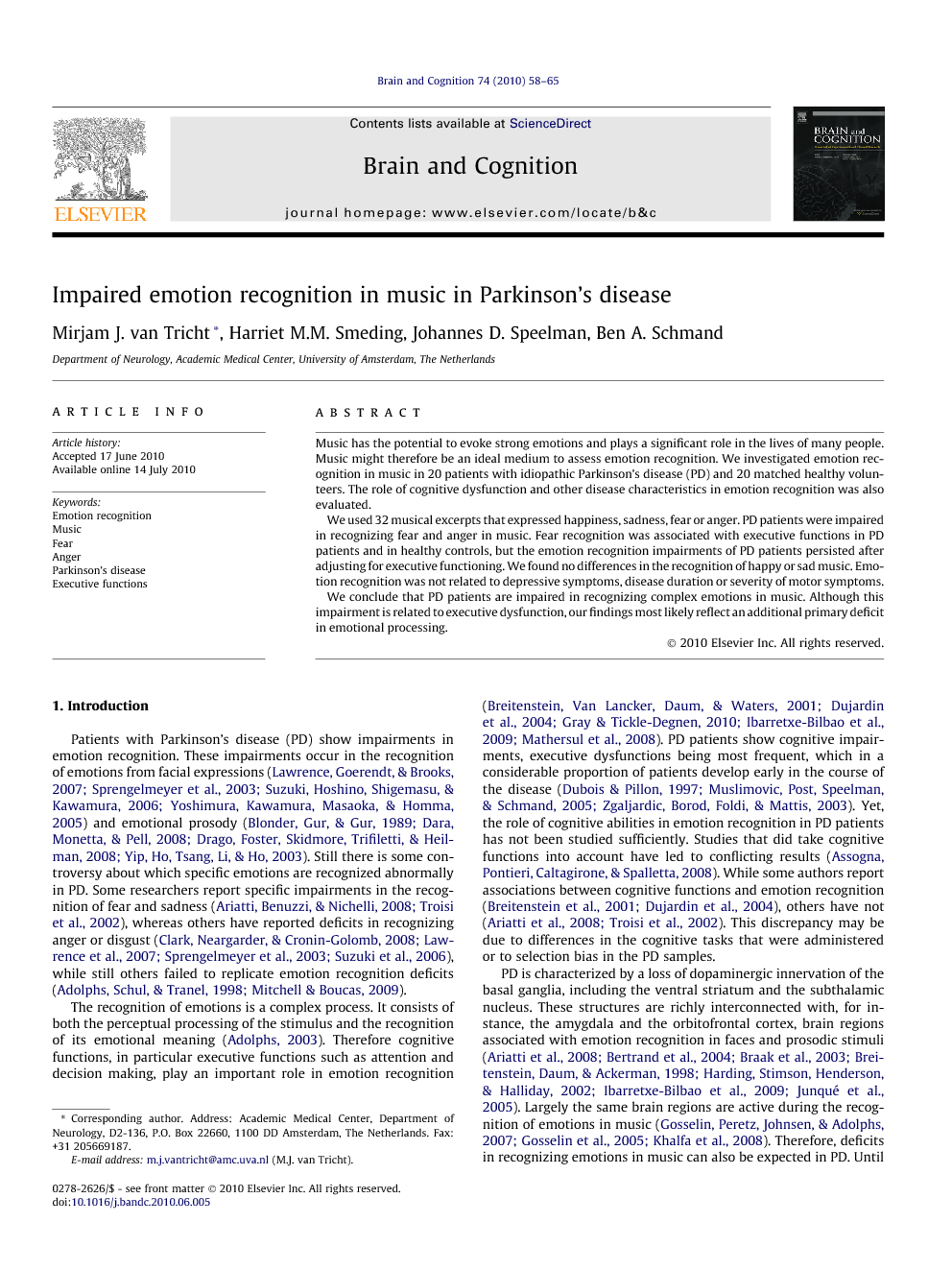Patients with Parkinson’s disease (PD) show impairments in emotion recognition. These impairments occur in the recognition of emotions from facial expressions (Lawrence et al., 2007, Sprengelmeyer et al., 2003, Suzuki et al., 2006 and Yoshimura et al., 2005) and emotional prosody (Blonder et al., 1989, Dara et al., 2008, Drago et al., 2008 and Yip et al., 2003). Still there is some controversy about which specific emotions are recognized abnormally in PD. Some researchers report specific impairments in the recognition of fear and sadness (Ariatti et al., 2008 and Troisi et al., 2002), whereas others have reported deficits in recognizing anger or disgust (Clark et al., 2008, Lawrence et al., 2007, Sprengelmeyer et al., 2003 and Suzuki et al., 2006), while still others failed to replicate emotion recognition deficits (Adolphs et al., 1998 and Mitchell and Boucas, 2009).
The recognition of emotions is a complex process. It consists of both the perceptual processing of the stimulus and the recognition of its emotional meaning (Adolphs, 2003). Therefore cognitive functions, in particular executive functions such as attention and decision making, play an important role in emotion recognition (Breitenstein et al., 2001, Dujardin et al., 2004, Gray and Tickle-Degnen, 2010, Ibarretxe-Bilbao et al., 2009 and Mathersul et al., 2008). PD patients show cognitive impairments, executive dysfunctions being most frequent, which in a considerable proportion of patients develop early in the course of the disease (Dubois and Pillon, 1997, Muslimovic et al., 2005 and Zgaljardic et al., 2003). Yet, the role of cognitive abilities in emotion recognition in PD patients has not been studied sufficiently. Studies that did take cognitive functions into account have led to conflicting results (Assogna, Pontieri, Caltagirone, & Spalletta, 2008). While some authors report associations between cognitive functions and emotion recognition (Breitenstein et al., 2001 and Dujardin et al., 2004), others have not (Ariatti et al., 2008 and Troisi et al., 2002). This discrepancy may be due to differences in the cognitive tasks that were administered or to selection bias in the PD samples.
PD is characterized by a loss of dopaminergic innervation of the basal ganglia, including the ventral striatum and the subthalamic nucleus. These structures are richly interconnected with, for instance, the amygdala and the orbitofrontal cortex, brain regions associated with emotion recognition in faces and prosodic stimuli (Ariatti et al., 2008, Bertrand et al., 2004, Braak et al., 2003, Breitenstein et al., 1998, Harding et al., 2002, Ibarretxe-Bilbao et al., 2009 and Junqué et al., 2005). Largely the same brain regions are active during the recognition of emotions in music (Gosselin et al., 2007, Gosselin et al., 2005 and Khalfa et al., 2008). Therefore, deficits in recognizing emotions in music can also be expected in PD. Until now, most studies on emotion recognition in PD have used facial or prosodic stimuli. Emotion recognition in other relevant modalities such as music or other art forms has received no or scarce attention. Music is a powerful instrument in evoking emotional responses (Baumgartner et al., 2006, Juslin and Sloboda, 2001, Koelsch, 2005, Menon and Levitin, 2005 and Peretz et al., 1998). In comparison to non-musical stimuli, such as pictures, music can elicit stronger emotions (Goldstein, 1980). Music might therefore be a better means to investigate emotion recognition in PD than faces or prosodic stimuli.
The primary aim of this study was to investigate the recognition of emotions in music in a group of PD patients and a group of healthy volunteers. We aimed at gaining insight in the extent of emotional deficits in PD patients: if PD patients are indeed less able to recognize emotions in music than controls, this would entail even broader deficits in emotion recognition in PD, spanning across modalities other than faces and prosody. Moreover, given the fact that music may provoke stronger emotions than other stimuli, our study might allow a clearer sight at the determinants of emotional deficits in PD patients.
Based on the above considerations, we hypothesized that PD patients are impaired in the recognition of emotions in music. We also expected to find a relationship between emotion recognition and executive functions. We examined if possible group differences in emotion recognition would persist after controlling for executive functioning. If so, then it would imply an independent, non-cognitive effect of PD on emotion recognition. In view of the high prevalence of psychiatric disturbances in PD, in particular depression (Schrag, 2004), we also controlled for depressive symptoms. Furthermore, we explored the relationship between emotion recognition and disease variables, e.g. disease duration, medication dosage and motor symptoms.


